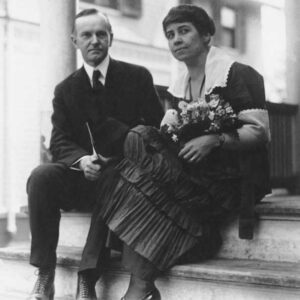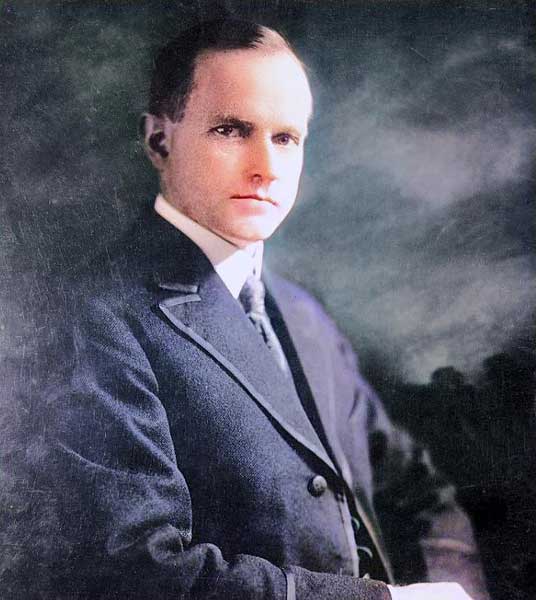
Calvin Coolidge, 1920. Touch of color LOA.
“The chief business of the American people is business.”
— President Calvin Coolidge
The United States 30th President was a man of few words but bold actions. John Calvin Coolidge was a true patriot, born on July 4, 1872, in Plymouth Notch, a small community in the Green Mountains of Vermont. His mother, Victoria, was a stay-at-home mom who instilled in Cavlin a strong work ethic and a commitment to public service throughout his early childhood. His father, John Coolidge, farmed, was a storekeeper, and became a trusted local politician soon after Calvin’s birth, who would later wind up as a Justice of the Peace, swearing his son in as President of the United States.
Calvin’s early years were marked by loss. His mother, Victoria, died from suspected tuberculosis when he was only 12. His only sibling, a younger sister Abigail Grace, died five years later from appendicitis. Calvin, a bit frail, would look to his father and grandmother for continued guidance growing up. Although not a stand-out student, Coolidge entered the Black River Academy at age 13. Like high school, Coolidge’s studies focused on Latin, Greek, history, and mathematics. It was also here that Calvin began his lifelong study of the U.S. Constitution. According to the Coolidge Foundation, Calvin would later praise the document, writing, “No other document devised by the hand of man ever brought so much progress and happiness to humanity.”
After graduating from Black River Academy on May 23, 1890, Coolidge attended Amherst College that fall. However, after an illness, he instead took preparatory work during the spring term at St. Johnsbury Academy. In September 1891, Calvin started back at Amherst, where his studies became critical to his career development. He later wrote, “Education is to teach men not what to think but how to think.” His father, John, would remarry in 1891 to school teacher Caroline Brown, whom Calvin had known all his life. He would say later in life, “For thirty years, she watched over me and loved me…”
During his studies under Professor Charles Garman, Coolidge learned the law of service, under which men don’t concentrate efforts on what they receive but rather on what they give. The education at Amherst would lead to his long career in public service. In December of 1894, Coolidge wrote The Principals Fought For in the American Revolution, an essay submitted in a contest sponsored by the National Society of the Sons of the American Revolution, in which he wrote:
“When history looks beyond the immediate cause of the American Revolution for the justifying principles, it is very soon brought back to the spirit of English liberty. It is the same genius for freedom that has led the race from the primeval forests of Germany to the Thirteenth Amendment of the Constitution.”
While Calvin graduated A.B., cum laude, in June 1895, the essay won first place in the national contest a year later. By then, Coolidge was studying law the old-fashioned way by reading the law at an established law firm in Northhampton, Massachusetts, beginning his apprenticeship in September of 1895. He was admitted to the Massachusetts Bar two days before his 25th Birthday in 1897 and, by February 1898, had opened his own law office in Northampton.
In 1905, Calvin was introduced to Grace Anna Goodhue, who was a teacher at the Clarke School for the Deaf. Coolidge and Goodhue married that year and would have two sons, John, born in 1906, and Calvin Jr., born in 1908. According to the Coolidge Foundation, Coolidge would later say, “We thought we were made for each other. For almost a quarter of a century, she has borne with my infirmities, and I have rejoiced in her graces”.
Calvin was already delving into politics, joining the Amherst Republican Club in 1892, and in 1899 served one term as Northhampton City Councilman. He would be elected Mayor of Northhampton in 1910, serving two one-year terms, Massachusetts State Senator, serving from 1912-1915, Lieutenant Governor from 1926-1918, and Governor of Massachusetts from 1919-1920. He was catapulted into the national spotlight for his stand against the 1919 Boston Police Strike, writing to Samuel Gompers, the President of the American Federation of Labor, “There is no right to strike against the public safety by anybody, anywhere, any time.”
During the Republican convention of 1920, delegates rejected the party leadership’s candidate for Vice President and instead enthusiastically chose Coolidge to be Warren G. Harding’s running mate. Harding, a fiscal conservative, represented a trend in government that departed from the progressive movement that had dominated Congress since President Theodore Roosevelt. Harding and Coolidge won the 1920 Presidential election with the greatest popular vote margin up to that time; however, Harding’s first few years in office were marred by scandal and corruption. Harding died suddenly on August 2, 1923, while Coolidge was at the family home in Plymouth Notch, Vermont. At 2:47 am, August 3, by the light of a kerosene lamp, Coolidge took the oath of office, sworn in by his father, a notary public, becoming the 30th President of the United States.
President Coolidge wasted no time in cleaning up the corruption he inherited, quietly restoring integrity to the executive branch. Coolidge ran for President again in 1924 with the slogan “Keep Cool with Coolidge.” He won in another landslide victory, gaining 54% of the vote out of three candidates. His address to a joint session of Congress on December 6, 1923, would be the first to be broadcast on national radio, and it is estimated about half of the United States listened.
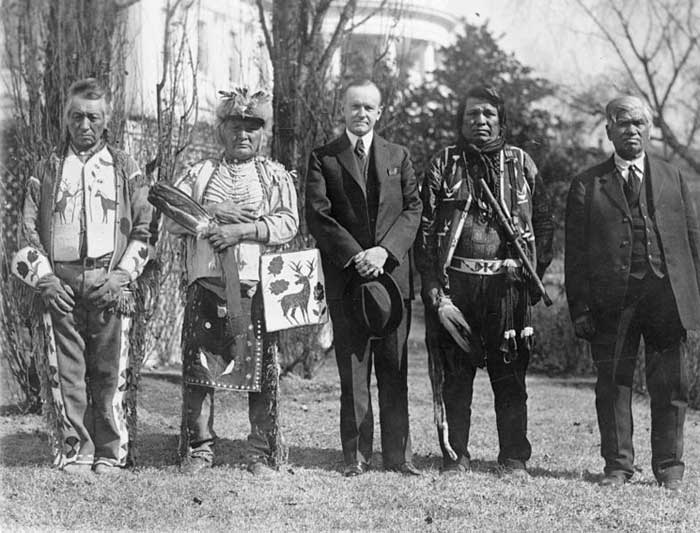
President Calvin Coolidge with four Osage Indians after Coolidge signed the bill granting Indians full citizenship in 1924.
During his time in office, Coolidge concentrated on cutting taxes, reducing the deficit, and making the government more efficient. He used the newly created Bureau of the Budget to bring order and direction to the process, achieving the governmental savings he sought. The nation saw its $22.3 billion debt reduced to $16.9 billion and slashed Federal taxes for most Americans with the Revenue Act of 1926. Also, during his Presidency, America saw a booming economy, with actual earnings growing 22% for wage earners and unemployment averaging only 3.3%. One of his more famous quotes of the 1920s captured the essence of his policy of noninterference and support of Industry, saying, “The chief business of the American people is business.” He also strongly supported civil rights, signing the Indian Citizenship Act in 1924 and granting citizenship to Native Americans.
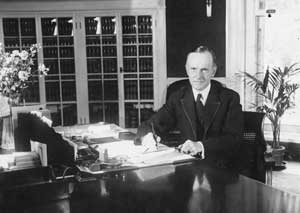
Calvin Coolidge
He maintained the popular support of the people by continuing his pioneering use of radio, speaking directly to Americans, becoming the country’s first radio president, and making over 50 major addresses. He would oversee the establishment of the Federal Communications Commission (FCC), a regulatory body for the new ‘radio’ technology, in 1927, which established the structure under which radio would blossom. Despite all that, he was a man of few words, earning him the nickname “Silent Cal.”
President Coolidge could have easily won re-election in 1928, but instead chose not to run, saying “I know how to save money. All my training has been in that direction. The country is in a sound financial condition. Perhaps the time has come when we ought to spend money. I do not feel that I am qualified to do that... It’s a pretty good idea to get out when they still want you”. President Coolidge’s commitment to fiscal conservatism and civil rights played a significant part in shaping America in important ways. As he left office in March of 1929, he was asked what he considered his most important accomplishment, to which he replied “Minding my own business.”
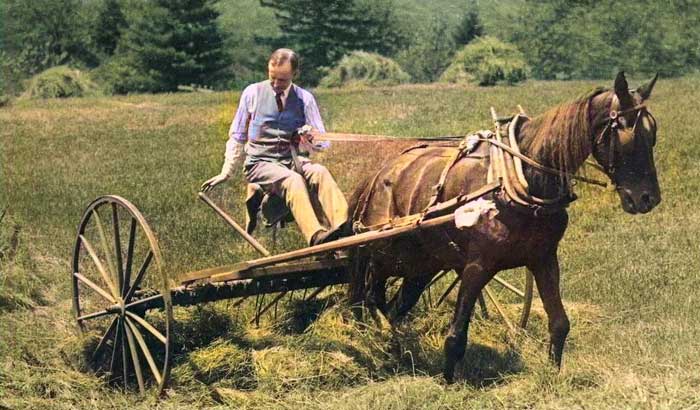
Calvin Coolidge at Father’s Farm in Vermont. Touch of color LOA.
Calvin Coolidge retired to Northhampton and served on the National Transportation Committee and as a director of the New York Life Insurance Company over the next few years. The former president suffered a heart attack and died on January 5, 1933, at the age of 60. His wife, Grace, who had always been by his side, lived another 24 years devoting herself to the hearing impaired. Their son Calvin Jr. died during the 1924 presidential campaign; however, their son, John Coolidge, would live a long, productive life as a business executive and entrepreneur with the New York, New Haven, and Hartford Railroad, dying in 2000 at the age of 93.
©Dave Alexander, Legends of America, April 2023.
Also See:
Indigenous Americans Long Path to U.S. Citizenship
Presidents of the United States
Presidential Trivia, Fun Facts, and Firsts
Sources:
White House Historical Association
Calvin Coolidge Foundation
Britannica

